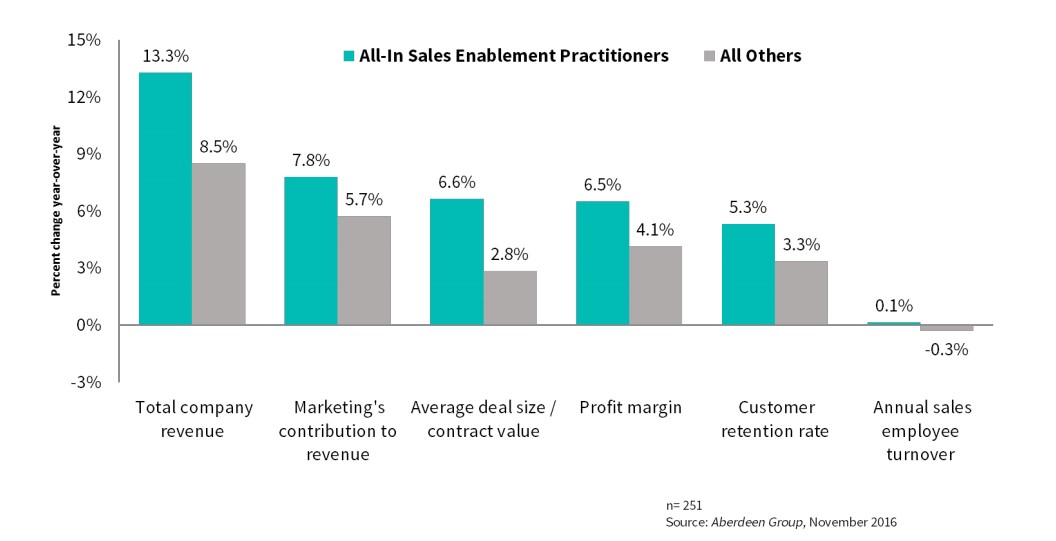sales-marketing-content
Tomato, Tomahto: How to Achieve “All In” Sales Enablement
 In February 2015, an image went viral. It was a photo of a formal dress that induced a polarizing debate based on how people responded to one simple question: is the dress blue and black or white and gold? While the dress was in fact blue and black, for some people, the image did and always will appear white and gold. Were they wrong to believe that?
In February 2015, an image went viral. It was a photo of a formal dress that induced a polarizing debate based on how people responded to one simple question: is the dress blue and black or white and gold? While the dress was in fact blue and black, for some people, the image did and always will appear white and gold. Were they wrong to believe that?
Like the opinions about the dress, sales enablement is subjective. While achieving sales enablement might require a “blue and black” approach for some people, others fiercely believe that “white and gold” is the tried and true approach. And the truth is that both approaches can and often do work.
To reinforce that point, let’s look at some recent research from Aberdeen.
You Say Tomato, I Say Tomahto. Who’s Right about Sales Enablement?
In 2016, Aberdeen asked more than 550 sales and marketing teams a question: “do you practice sales enablement?” The answer was overwhelmingly yes, with 77% of respondents agreeing that they do. This is good news, but it begs the question of what that “yes” included in its definition of sales enablement.
When Aberdeen dug deeper, they found that most often, people’s ideas of sales enablement fell into one of three categories:
- Content-based Sales Enablement: Using tools and processes to increase the effectiveness and ease of use of sales and marketing materials.
- Technology-based Sales Enablement: Providing sales and marketing teams with technology-based tools that streamline processes.
- Education/Training-based Sales Enablement: Improving and/or adding training materials and processes to better educate sales and marketing teams.
For some people, enabling sales was all about sales training. Give your team the right training, and everything will fall into place. For others, training wasn’t nearly as important as having the right content for the sales process. Tomato, tomahto.
Before we go any further, see if you can guess which category is practiced most by B2B sales teams currently.
Got your answer ready? Good. Let’s find out if your hunch is correct.
The most popular form of sales enablement is… content-based enablement, with 52% of respondents actively pursuing it. Technology and training-based enablement came in second and third respectively, with 40% and 38% of organizations using it.
SEE ALSO: 5 Common Misconceptions About Sales Enablement
This leads us to another question: which of these categories is the best fit for sales enablement? Which one will lead you to the stronger sales growth that enablement so often promises?
The answer, according to Aberdeen, is “all of them.”
“All In” Sales Enablement
Imagine you’re hiring a brand new sales rep. You give her all the content she could possibly need—content that has been optimized to be the perfect fit for her buyers. But you don’t offer any sales training or technological tools to help her. Instead, you stick her on the sales floor with all that amazing content and say “go at it.”
Is that an effective approach to sales? Of course not. Do the same analogy with any of those three factors, and you’ll get the same result: sales inhibition instead of sales enablement.
Yes, that’s an extreme example, but it shows how ridiculous it is to put all your sales enablement eggs in one basket. Having incredibly well-trained reps who don’t have the proper tools is simply a waste of business efforts.
With an “all in” approach, you get a comprehensive strategy for improving the key areas where sales often fall short. Aberdeen research shows that “all in” sales enablers achieve 56% higher growth in annual revenue compared to the other respondents. They also have 57% higher profit margins year over year.

A “one and done” enablement effort is better than not doing anything at all, but don’t fall into the dangerous mindset that you’ve checked off sales enablement from your to-do list. Sales enablement isn’t about becoming really, really good at one aspect of sales. It’s about methodically improving every aspect of your process, tools, and resources over time. Start with the weakest link, and once you’ve strengthened that point, move on to the next weakest link.
Only 13.6% of the respondents to Aberdeen’s survey stated that they practiced all three types of sales enablement. Hopefully that number continues to grow as more organizations realize that the best approach to enabling your sales and marketing teams is to give them everything they need to succeed, not just one piece of the puzzle.











